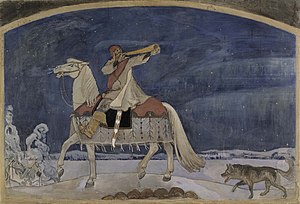
The English author J. R. R. Tolkien has often been supposed to have spoken of wishing to create "a mythology for England". It seems he never used the actual phrase, but various commentators have found his biographer Humphrey Carpenter's phrase appropriate as a description of much of his approach in creating Middle-earth, and the legendarium behind The Silmarillion.
His desire to create a national mythology echoed similar attempts in countries across Europe, especially Elias Lönnrot's creation of the Kalevala in Finland, which Tolkien read, mainly in English, and admired. That in turn inspired him to study the Finnish language, which he found beautiful. He imitated some of its features in one of his constructed languages, which became the Elvish language Quenya. He studied Welsh, too, and it led to another Elvish language, Sindarin. He realized that he needed some speakers of those languages, leading him to create tales of elves divided into different groups. Meanwhile, his study of Old English led him to read Crist I, which mentioned a character named Earendel, described as the brightest. This attractive but puzzling description led Tolkien to write the 1914 "Voyage of Earendel the Evening Star": it became the first component of his mythology.
Tolkien attempted to reconstruct an English mythology, leading up to how the brothers Hengest and Horsa led the Jutes to Britain and founded England. He made a story that fitted together well, though he knew it was probably not what had happened. Without an actual mythology, he looked to Norse and other mythologies, and gathered hints from Old English and other medieval manuscripts. Beowulf gave him ents, elves, and orcs; Sir Gawain and the Green Knight lent the woodwoses.
The resulting legendarium, formed in the First World War and reshaped in the interwar period, reflected the state of twentieth century England, as the empire faded, wars threatened, and the country was filled with factions and dissenting voices. The result, Verlyn Flieger comments, is nearer to the vision of George Orwell's Nineteen Eighty-Four than escapist fantasy. Dimitra Fimi, on the other hand, comments that the setting is the whole of Northwestern Europe, not just England, and with its incorporation of the "Celtic", it could be described more inclusively as a "Mythology for Britain".
Cite error: There are <ref group=T> tags on this page, but the references will not show without a {{reflist|group=T}} template (see the help page).